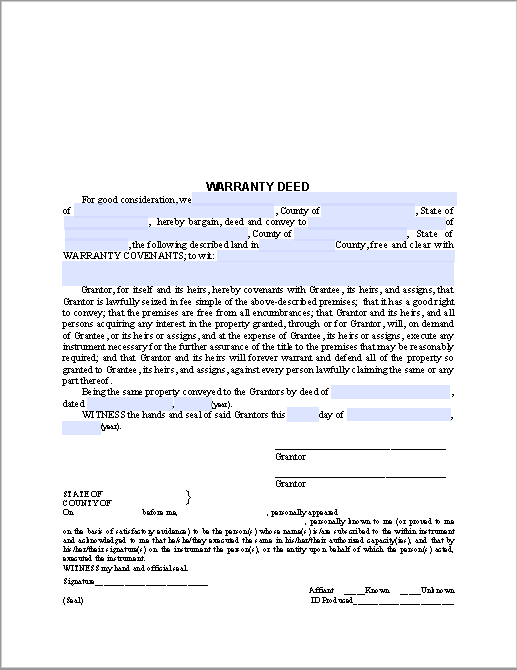Download this Free Warranty Deed Form in PDF Format to help you generate your own Warranty Deed whenever you want.
A Warranty Deed is a legal document used in real estate transactions to transfer ownership of property from the seller to the buyer. It serves as proof of sale and provides a warranty that the property is free from any liens or encumbrances. This deed is crucial for both parties as it ensures the buyer’s rights and the seller’s responsibilities.
Importance of the Warranty Deed
The Warranty Deed is vital for several reasons:
- Proof of Ownership Transfer:
- It legally transfers ownership and rights of the property from the seller to the buyer.
- Buyer’s Assurance:
- It guarantees that the property is free from any undisclosed liens, encumbrances, or claims.
- Seller’s Liability:
- The seller confirms that there are no hidden liabilities or issues with the property. If any issues arise, the seller is responsible for resolving them.
Useful Tips for Writing the Warranty Deed
Although creating a Warranty Deed involves legal formalities, here are some essential tips to keep in mind:
- Legal Assistance:
- Consult with a lawyer or a local property department to draft the Warranty Deed to ensure it meets legal standards.
- Complete Information:
- Ensure all necessary details are included, such as names of the seller(s) and buyer(s), property description, agreed price, and dates.
- Signatures and Witnesses:
- The deed must be signed by all parties involved, including witnesses and a notary public or property registrar.
- Warranty Statement:
- Include a statement where the seller warrants that there are no undisclosed liens, mortgages, or claims on the property.
- Responsibility Clause:
- Clearly state that the seller will resolve any issues that arise post-sale related to undisclosed liabilities.
Warranty Deed Form {PDF}
Here is a preview of a Free Fill-able Warranty Deed Form as a PDF,

Here is the download link for this Warranty Deed Form,
Key Elements to Include in the Warranty Deed
- Parties Involved:
- Names and addresses of the seller(s) and buyer(s).
- Property Description:
- Legal description of the property, including address and boundaries.
- Sale Details:
- Agreed purchase price.
- Transfer Date:
- Date when the ownership transfer takes place.
- Warranty Clause:
- A statement confirming that the seller guarantees the property is free from any liens or encumbrances.
- Signature Section:
- Signatures of the seller(s), buyer(s), witnesses, and notary public or property registrar.
Sample Warranty Deed
Here’s a sample template for a Warranty Deed:
WARRANTY DEED
This Deed is made this [Day] day of [Month], [Year], by and between:
Grantor (Seller):
[Seller’s Full Name]
[Seller’s Address]Grantee (Buyer):
[Buyer’s Full Name]
[Buyer’s Address]Description of Property:
[Legal Description of the Property, including address and boundaries]Consideration:
The total purchase price of the property is [Purchase Price], which the Grantee has paid to the Grantor.Warranty Clause:
The Grantor warrants to the Grantee that the property is free from any liens, mortgages, or encumbrances and that the Grantor has full legal right and authority to sell and transfer the property. The Grantor further warrants that they will defend the title against any claims and demands of all persons.Signatures:
Grantor:
[Seller’s Full Name]
Date: _______________Grantee:
[Buyer’s Full Name]
Date: _______________Witnesses:
[Witness Name]
Date: _______________
[Witness Name]
Date: _______________Notary Public/Property Registrar:
Subscribed and sworn to before me this [Day] day of [Month], [Year].
[Notary Public/Registrar Name]
Date: _______________My commission expires: _______________
By following these guidelines and using the sample template, you can ensure that the Warranty Deed is comprehensive, legally sound, and protects the interests of both the buyer and the seller in the real estate transaction.
